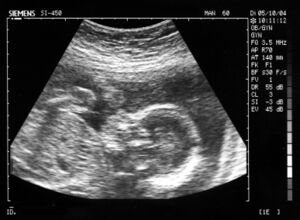Infrasuoni e ultrasuoni: applicazioni en
Da "Fisica, onde Musica": un sito web su fisica delle onde e del suono, acustica degli strumenti musicali, scale musicali, armonia e musica.
Jump to navigation Jump to search- Not all sounds can be perceived by the human ear. In particular sounds with frequencies below 20 Hz, called infrasounds, and those with frequencies above 20000 Hz, called ultrasounds, are conventionally considered not at all perceptible. To learn more about the mechanism of the perception of pitch, see the page on audible frequencies.
- Infrasounds are produced by all types of low-frequency mechanical vibrations made by ovens, machines with rotating parts, diesel engines, compressors, fans, ground vibrations caused by heavy vehicles, longitudinal waves of earthquakes, etc. Even though infrasounds cannot be heard, they are, especially if accompanied by loud sound waves, perceptible through the skeleton. This experience is common to anyone who has been near the giant speakers of a music concert or in a discothèque, where you can feel the vibrations of the basses rhythmically pounding "in your chest".
- Ultrasounds can be produced by setting a thin quartz plate in vibration due to the piezoelectric effect; i.e. by applying voltage to it at the desired ultrasound frequency. The same device can work in reverse: if the quartz plate receives ultrasounds, it will begin to vibrate producing a measurable current. This device can be used to detect ultrasounds in the environment.
Types and uses of ultrasounds
Ultrasounds are conventionally divided into three frequency bands:
- high frequency ultrasounds, from 1 MHz to 10 MHz, which are used primarily for medical diagnostic purposes;
- medium frequency ultrasounds, from 100 kHz to 10 MHz, which are used for medical therapeutic purposes because they heat up body tissues and, when used in appropriate doses, can eradicate microorganisms or treat rheumatism;
- low frequency ultrasounds, from 20 kHz to 100 kHz, which are produced by certain types of industrial systems that use compressors, reactors or gas-powered turbines.
- High frequency ultrasounds are used in medicine, for example, in ultrasonography, which allows for the observation of internal parts of the human body without damaging the patient using a method that is similar to that based on x-rays but with much less penetration and lower resolution. This is done by vibrating quartz crystals to generate ultrasounds that are then directed at various angles over the areas of the body to be studied. The reflected waves are detected many times per second in order to obtain a series of images that can also be sequenced to create a film. For more information on this, see the page on sound reflection.
- Ultrasounds are used to sterilise milk, detect impurities or anomalies in metals, perforate materials without having contact with a point, blend liquids, clean valuable objects and remove incrustations from surfaces such as dentures.
- SONAR (SOund NAvigation and Ranging) also uses the properties of ultrasounds, which can propagate in water for many kilometres. This device permits the determination of water depth and the monitoring of the floor to retrieve information on the natural environment or the presence of sunken vessels. SONAR is based on a simple mechanism: ultrasounds are generated and aimed at objects that reflect them. Then a detector collects the reflected waves and notes the speed of sound in the water and the entire time taken by the radio waves to travel back and forth. This information is used to calculate the distance of the object in question.
- Certain animals, such as bats, use ultrasounds to move in the dark or capture prey at night. They produce ultrasounds and aim them in the direction that they need to detect and estimate the "back and forth" time and therefore their distance from the object.
- The echocardiogram is based on the use of ultrasounds. This technique allows for the observation of various parts of the heart, which have different densities and, therefore, reflect sound waves differently allowing for a precise diagnosis of any pathologies present after an accurate analysis of the collected data.
Damages from exposure to ultrasounds
- The categories at risk are those related to activities that produce infrasounds and ultrasounds.
- Low frequency ultrasounds can be transmitted to the human body through the skin and may cause nausea, vomiting, asthenia and vertigo, especially after long exposure.
- The risk can be reduced by taking such precautions as checking insulation systems and wearing protective clothing prior to exposure.
In-depth study and links
- We have mentioned the phenomenon of sound reflection several times on this page. Therefore, we encourage you to visit the page in question.
Categoria:


